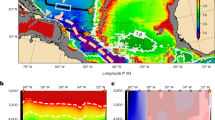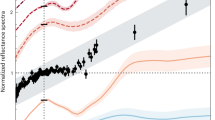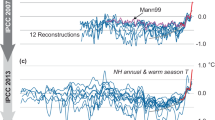Abstract
Observations of cometary nuclei have revealed a very limited amount of surface water ice1,2,3,4,5,6,7, which is insufficient to explain the observed water outgassing. This was clearly demonstrated on comet 9P/Tempel 1, where the dust jets (driven by volatiles) were only partially correlated with the exposed ice regions8. The observations6,7 of 67P/Churyumov–Gerasimenko have revealed that activity has a diurnal variation in intensity arising from changing insolation conditions. It was previously concluded that water vapour was generated in ice-rich subsurface layers with a transport mechanism linked to solar illumination1,2,3,5, but that has not hitherto been observed. Periodic condensations of water vapour very close to, or on, the surface were suggested3,9 to explain short-lived outbursts seen near sunrise on comet 9P/Tempel 1. Here we report observations of water ice on the surface of comet 67P/Churyumov–Gerasimenko, appearing and disappearing in a cyclic pattern that follows local illumination conditions, providing a source of localized activity. This water cycle appears to be an important process in the evolution of the comet, leading to cyclical modification of the relative abundance of water ice on its surface.
This is a preview of subscription content, access via your institution
Access options
Subscribe to this journal
Receive 51 print issues and online access
$199.00 per year
only $3.90 per issue
Buy this article
- Purchase on Springer Link
- Instant access to full article PDF
Prices may be subject to local taxes which are calculated during checkout




Similar content being viewed by others
References
Soderblom, L. A. et al. Observations of Comet 19P/Borrelly by the miniature integrated camera and spectrometer aboard Deep Space 1. Science 296, 1087–1091 (2002)
Sunshine, J. M. et al. Exposed water ice deposits on the surface of comet 9P/Tempel 1. Science 311, 1453–1455 (2006)
A’Hearn, M. F. et al. EPOXI at comet Hartley 2. Science 332, 1396–1400 (2011)
Capaccioni, F. et al. The organic-rich surface of comet 67P/Churyumov-Gerasimenko as seen by VIRTIS/Rosetta. Science 347 http://dx.doi.org/10.1126/science.aaa0628 (2015)
Feaga, L. M. et al. Asymmetries in the distribution of H2O and CO2 in the inner coma of Comet 9P/Tempel 1 as observed by Deep Impact. Icarus 190, 345–356 (2007)
Gulkis, S. et al. Subsurface properties and early activity of comet 67P/Churyumov-Gerasimenko. Science 347 http://dx.doi.org/10.1126/science.aaa0709 (2015)
Sierk, H. et al. On the nucleus structure and activity of comet 67P/Churyumov-Gerasimenko. Science 347 http://dx.doi.org/10.1126/science.aaa1044 (2015)
Farnham, T. L. et al. Dust coma morphology in the Deep Impact images of Comet 9P/Tempel 1. Icarus 191, 146–160 (2007)
Prialnik, D., A’Hearn, M. F. & Meech, K. J. A mechanism for short-lived cometary outbursts at sunrise as observed by Deep Impact on 9P/Tempel 1. Mon. Not. R. Astron. Soc. 388, L20–L23 (2008)
Coradini, A. et al. An imaging spectrometer for the Rosetta mission. Space Sci. Rev. 128, 529–559 (2007)
Filacchione, G. et al. Saturn’s icy satellites and rings investigated by Cassini-VIMS: III — Radial compositional variability. Icarus 220, 1064–1096 (2012)
Mottola, S. et al. The rotation state of 67P/Churyumov-Gerasimenko from approach observations with the OSIRIS cameras on Rosetta. Astron. Astrophys. 569, L2 (2014)
Warren, S. G. Optical constants of ice from the ultraviolet to the microwave. Appl. Opt. 23, 1206–1225 (1984)
Mastrapa, R. M. et al. Optical constants of amorphous and crystalline H2O-ice in the near infrared from 1.1 to 2.6 µm. Icarus 197, 307–320 (2008)
Mastrapa, R. M. et al. Optical constants of amorphous and crystalline H2O-ice: 2.5–22 µm (4000–455 cm-1) optical constants of H2O-ice. Astrophys. J. 701, 1347–1356 (2009)
Clark, R. N. et al. The surface composition of Iapetus: mapping results from Cassini VIMS. Icarus 218, 831–860 (2012)
Hapke, B. Theory of Reflectance and Emittance Spectroscopy (Cambridge Univ. Press, 2012)
Tosi, F. et al. Thermal measurements of dark and bright surface features on Vesta as derived from Dawn/VIR. Icarus 240, 36–57 (2014)
Fray, N. & Schmitt, B. Sublimation of ices of astrophysical interest: a bibliographic review. Planet. Space Sci. 57, 2053–2080 (2009)
Rubin, M. et al. Mass transport around comets and its impact on the seasonal differences in water production rates. Astrophys. J. 788, 168 (2014)
Crifo, J. F., Loukianov, G. A., Rodionov, A. V. & Zakharov, V. V. Navier-Stokes and direct Monte Carlo simulations of the circumnuclear coma II. Homogeneous, aspherical sources. Icarus 163, 479–503 (2003)
De Sanctis, M. C., Lasue, J. & Capria, M. T. Seasonal effects on comet nuclei evolution: activity, internal structure, and dust mantle formation. Astron. J. 140, 1–13 (2010)
Rosenberg, E. D. & Prialnik, D. The effect of internal inhomogeneity on the activity of comet nuclei — application to Comet 67P/Churyumov-Gerasimenko. Icarus 209, 753–765 (2010)
De Sanctis, M. C. et al. Shape and obliquity effects on the thermal evolution of the Rosetta target 67P/Churyumov-Gerasimenko cometary nucleus. Icarus 207, 341–358 (2010)
Sunshine, J. M. et al. Water ice on comet 103P/Hartley 2. EPSC-DPS Joint Meeting 2011, 1345 (2011); available at http://meetingorganizer.copernicus.org/EPSC-DPS2011/EPSC-DPS2011-1345.pdf
Vincent, J. B. et al. Large heterogeneities in comet 67P as revealed by active pits from sinkhole collapse. Nature 523, 63–66 (2015)
Ciarniello, M. et al. Hapke modeling of Rhea surface properties through Cassini-VIMS spectra. Icarus 214, 541–555 (2011)
De Sanctis, M. C., Capria, M. T. & Coradini, A. Thermal evolution model of 67P/Churyumov-Gerasimenko, the new Rosetta target. Astron. Astrophys. 444, 605–614 (2005)
Capria, M. T., Coradini, A., De Sanctis, M. C. & Blecka, M. I. P/Wirtanen thermal evolution: effects due to the presence of an organic component in the refractory material. Planet. Space Sci. 49, 907–918 (2001)
JPL Small-Body Database Browser 67P/Churyumov-Gerasimenko. http://ssd.jpl.nasa.gov/sbdb.cgi (NASA/Jet Propulsion Laboratory)
Acknowledgements
We thank the following institutions and agencies, which supported this work: the Italian Space Agency (ASI, Italy), Centre National d’Etudes Spatiales (CNES, France), Deutsches Zentrum für Luft- und Raumfahrt (DLR, Germany), and the National Aeronautic and Space Administration (NASA, USA). VIRTIS was built by a consortium from Italy, France and Germany, under the scientific responsibility of the Istituto di Astrofisica e Planetologia Spaziali of the INAF (Italy), which also guides the scientific operations. The VIRTIS instrument development for ESA has been funded and managed by ASI, with contributions from Observatoire de Meudon financed by CNES (France), and from DLR (Germany). We also thank the Rosetta Science Ground Segment and the Rosetta Mission Operations. The VIRTIS calibrated data will be available through the ESA’s Planetary Science Archive (PSA) website.
Author information
Authors and Affiliations
Consortia
Contributions
M.C.D.S. and F.C. contributed to data analysis and the writing of the manuscript. G.F. and F.C. provided calibrated VIRTIS data. A.R. and M.C. provided the spectral fit. M.C.D.S., M.T.C., M.F. and S.T. provided the thermal modelling. F.T. retrieved the temperatures. All authors contributed to the discussion of the results and to the writing of the paper.
Corresponding author
Ethics declarations
Competing interests
The authors declare no competing financial interests.
Extended data figures and tables
Extended Data Figure 1 Spectral fit.
a, b, Two mixing modalities, intimate (a) and areal (b), are used to model the same spectrum; the spectrum is identified by its position in the acquired image (‘sample’ and ‘line’) and its spacecraft event time (scet). The three missing parts of the spectra are related to the wavelength ranges covered by the junctions of the filters which produce significant artefacts. They are thus removed during the fitting procedure. The spectra are normalized with respect to λ0 = 1.8 μm. For the areal mixture case, the modelled absorption band at 2 µm is relevant, even with the small abundance (fH2O) and grain diameter (dH2O) we retrieved. This implies a worse fit, as indicated by the larger χ2 variable. The intimate mixture is thus a better model of the spectra.
Extended Data Figure 2 Spectral fits of comet nucleus spectra with different ice content.
From a to c, the depth of the absorption band at 3.2 μm decreases and the band centre moves slightly towards longer wavelengths. In all cases the spectra are well modelled with a decreasing amount of water ice (fH2O) and a constant grain diameter (dH2O) of that water ice. Missing parts of the spectra and normalization are as for Extended Data Fig. 1.
Extended Data Figure 3 Diurnal cycle of water.
In the case reported here, the sublimation of water vapour takes place in a deeper layer (see cartoon for a graphic explanation). The water vapour filters up to the surface layers (which are essentially dehydrated, as during the day we do not see any spectral signature of ice) where, finding lower temperature conditions (as in the night or in the shadow), it condenses and is trapped as ice. The subsequent illumination of the surface leads to absolute loss of the condensed water vapour. This is an effective mechanism of transport of H2O from deeper layers to the surface.
Extended Data Figure 4 Temperature and water vapour profiles.
a, Temperature profiles, and b, water vapour pressure profiles, from the nucleus surface to the interior at different times: the blue curve is the profile when the area is illuminated; the red curve is the profile obtained 6 min after passing into shadow; and the purple curve is about 40 min after passing into shadow.
Rights and permissions
About this article
Cite this article
De Sanctis, M., Capaccioni, F., Ciarniello, M. et al. The diurnal cycle of water ice on comet 67P/Churyumov–Gerasimenko. Nature 525, 500–503 (2015). https://doi.org/10.1038/nature14869
Received:
Accepted:
Published:
Issue Date:
DOI: https://doi.org/10.1038/nature14869
This article is cited by
-
Surface Compositions of Trojan Asteroids
Space Science Reviews (2024)
-
The Comet Interceptor Mission
Space Science Reviews (2024)
-
Dual storage and release of molecular oxygen in comet 67P/Churyumov–Gerasimenko
Nature Astronomy (2022)
-
Macro and micro structures of pebble-made cometary nuclei reconciled by seasonal evolution
Nature Astronomy (2022)
-
AMBITION – comet nucleus cryogenic sample return
Experimental Astronomy (2022)
Comments
By submitting a comment you agree to abide by our Terms and Community Guidelines. If you find something abusive or that does not comply with our terms or guidelines please flag it as inappropriate.



